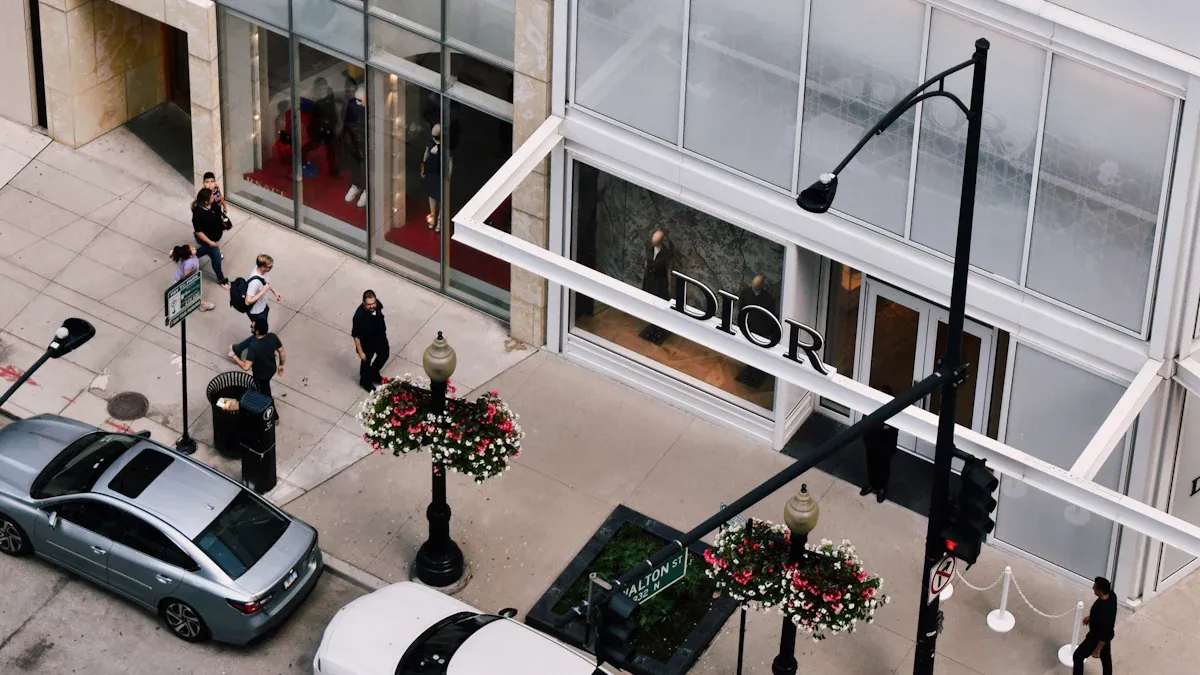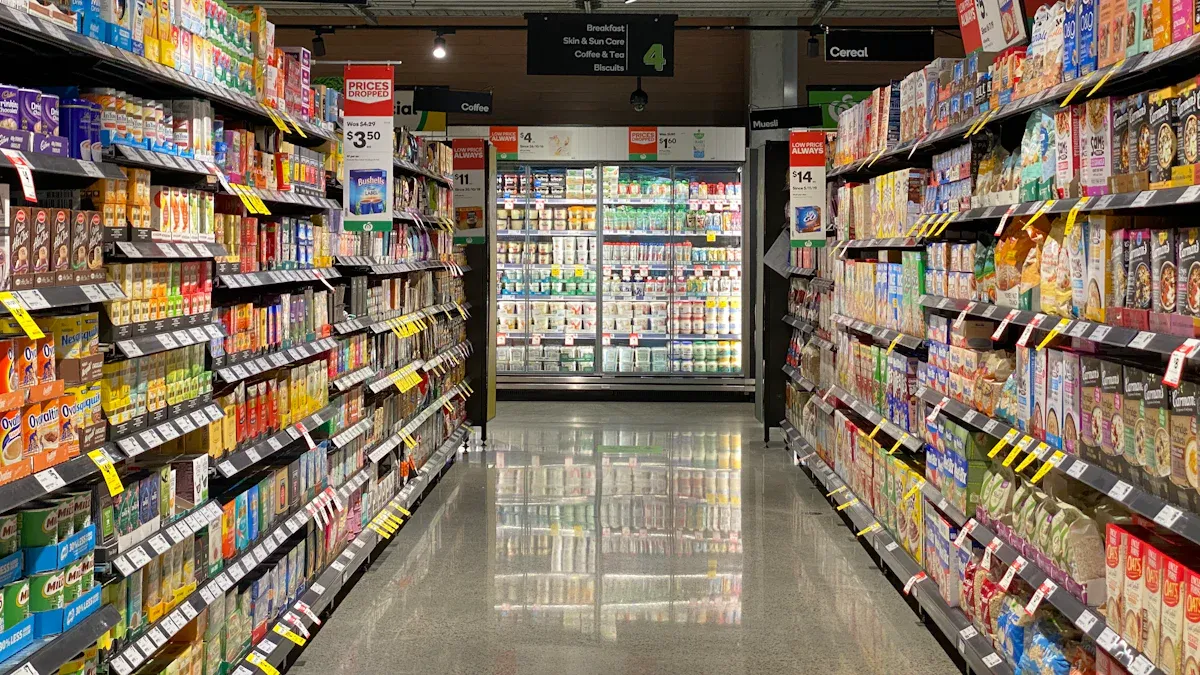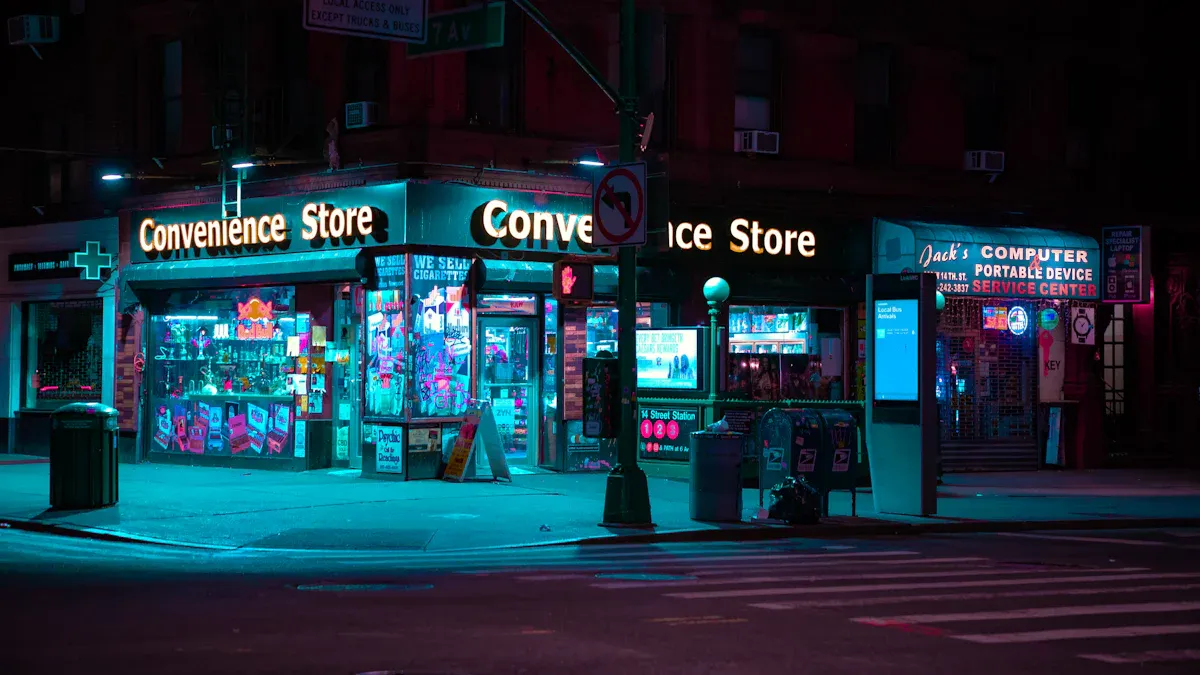The Evolution of Corner Stores: From Local Bodegas to Upscale American Joints

Have you noticed how your local convenience store has changed over the years? What used to be a simple spot for snacks and essentials has transformed into a sleek, modern destination. Today’s c-stores offer more than just convenience—they cater to your busy lifestyle with premium products, stylish designs, and even gourmet food options. Chains like Buc-ee’s and Rutter’s are leading this shift. For instance, Rutter’s saw a 15.6% increase in visits in early 2024, far outpacing the average. These changes show how the evolution of corner stores is reshaping the way customers shop and interact with their communities.
Key Takeaways
Today’s corner stores have changed from simple shops to fancy places. They now sell high-quality items and special foods.
Technology helps make shopping easier with things like phone payments and smart tools to track products.
Fancy stores care about health and the planet. They offer healthier food and items from nearby farms to please shoppers.
These modern stores are great for busy people but may cost more and be harder for old customers to afford.
In the future, corner stores will mix new ideas with fairness. They will try to help both new shoppers and local people.
The Origins of Local Bodegas

Community-Centered Beginnings
Bodegas have always been more than just stores. They started as small, family-run businesses that brought people together. The word "bodega" comes from the Spanish term for "wine cellar," but these shops evolved into something much bigger. During the 19th and early 20th centuries, bodegas became essential in places like Puerto Rico, the Dominican Republic, and Cuba. Families ran these stores, often offering credit to neighbors who needed it. When Puerto Rican migrants arrived in New York City in the 1950s, they brought this model with them. These bodegas transformed neighborhoods, becoming cultural hubs where people could connect and feel at home.
Products and Services of Traditional Bodegas
Walking into a traditional bodega, you’d find a little bit of everything. These stores stocked essentials like milk, bread, and canned goods, but they also carried unique items that reflected the community’s culture. You could grab plantains, spices, or even a quick snack. Many bodegas also offered services like money transfers or phone cards, making them a one-stop shop for locals. They weren’t just about food; they were about convenience and connection. For immigrants, these stores were a lifeline, offering familiar products and a friendly face in a new country.
Cultural and Social Importance
Bodegas have always been at the heart of their communities. They’re more than just places to shop—they’re spaces where people gather, share stories, and build relationships. In Hispanic neighborhoods, bodegas often reflect the culture and traditions of their customers. For example, Dominican bodegas mirror the colmados of the Dominican Republic, where people socialize and play games. These stores also adapt to the needs of their neighborhoods. In low-income areas, bodegas outnumber supermarkets, providing essential goods to residents who might not have other options. They’re a symbol of resilience and community spirit, showing how small businesses can make a big impact.
Factors Behind the Evolution of Corner Stores
Changing Consumer Lifestyles
You’ve probably noticed how your shopping habits have changed over the years. Today, people want more than just products—they want experiences. Millennials and Gen Z, in particular, are driving this shift. They prefer brands that focus on sustainability and ethical practices. For example:
Many customers now choose stores that align with their values, like supporting eco-friendly packaging or fair-trade products.
Subscription services and loyalty programs have become popular because they offer personalized experiences.
Busy lifestyles mean you’re likely looking for quick, convenient options that save time.
This evolution of corner stores reflects these changes. Modern c-stores are no longer just about grabbing a soda or a snack. They’re adapting to your needs by offering healthier food options, prepared meals, and even gourmet coffee. Did you know that sales of prepared food in c-stores have increased by 12.2% year-over-year? It’s clear that these stores are becoming viable alternatives to fast-food chains, catering to your desire for convenience without sacrificing quality.
Urbanization and Gentrification
As cities grow and change, so do the corner stores within them. Urban areas often have limited space, making it hard for large supermarkets to operate. That’s where c-stores step in. They offer a compact, accessible shopping experience that fits perfectly into the hustle and bustle of city life.
Evidence Description | Connection to Query |
|---|---|
Urbanization and Limited Space: In densely populated urban areas, space is often limited, making it challenging for larger supermarkets to operate. Convenience stores fill this gap by offering a compact shopping experience in easily accessible locations. | This indicates that urbanization trends directly affect the operational viability of corner stores, as they cater to the needs of urban consumers in limited spaces. |
Changing Lifestyles: Busy schedules, longer working hours, and the need for convenience have led consumers to rely on convenience stores for quick and easy access to everyday essentials. | This highlights how urbanization influences consumer behavior, increasing the demand for corner stores as a result of lifestyle changes. |
But urbanization isn’t the only factor. Gentrification also plays a big role. As neighborhoods transform, so do their corner stores. High-tech firms moving into urban areas create jobs and boost local economies, but they also drive up rents. This often displaces long-term residents and changes the types of businesses in the area. Corner stores adapt by offering upscale products and modern designs to appeal to new, wealthier customers. While this evolution of corner stores brings innovation, it also raises concerns about affordability and accessibility for long-time residents.
The Role of Technology in Retail
Technology has completely reshaped the way you shop. Modern c-stores are embracing digital solutions to make your experience faster and more personalized. For instance:
Many stores now use AI to manage inventory, reducing stockouts by up to 50%.
Digital loyalty programs reward you for your purchases, encouraging you to return.
Mobile payment options and self-checkout kiosks make transactions seamless.
Metric | Impact |
|---|---|
Lower overhead | 10-15% of revenue |
Higher inventory turns | 8-12 times annually |
Rich customer insights through data | Essential for competitive advantage |
Omnichannel customers spend more | 4% more in-store, 10% more online |
AI in inventory management | 20-50% reductions in stockouts |
Personalization technologies | 40% increase in average order value |
These innovations aren’t just about convenience—they’re about creating a better shopping experience for you. Imagine walking into a c-store where the shelves are stocked with items you love, thanks to data-driven insights. Or using an app to pre-order your coffee so it’s ready when you arrive. It’s no wonder that 71% of retail businesses see digital transformation as crucial to their strategy.
Technology is also helping c-stores evolve into community hubs. With features like EV charging stations and clean, modern designs, these stores are becoming more than just places to shop—they’re becoming destinations.
Features of Modern Upscale C-Stores

Premium and Niche Product Offerings
When you step into a modern c-store, you’ll notice something different right away. The shelves aren’t just stocked with the usual chips and sodas. Instead, you’ll find premium and niche products that cater to today’s conscious shoppers. These stores are redefining convenience by offering healthier food options, organic snacks, and even natural food items.
Many upscale c-stores focus on wellness by featuring health and wellness products like organic cosmetics or locally sourced goods.
You’ll often see a “local-first” approach, with stores showcasing products from nearby farms or small businesses.
Some stores even highlight items from marginalized groups, making your shopping experience feel more meaningful.
This shift isn’t just about offering better products; it’s about creating a connection with you. Stores like Casey’s have upgraded their food offerings, adding fresh pizza and curbside pickup to meet your needs. Meanwhile, chains like Wawa are setting the standard for gourmet options in c-stores. These changes reflect a growing demand for quality ingredients and sustainable choices.
If you’re someone who values wellness and quality, these next-generation corner stores are designed with you in mind. They’re not just places to grab a quick snack—they’re destinations for premium products that align with your lifestyle.
Modern Store Designs and Experiences
Upscale c-stores don’t just look different—they feel different too. Modern designs focus on creating a welcoming atmosphere that makes you want to stay a little longer. Forget the cluttered aisles of traditional stores. Today’s fancy convenience stores feature sleek, minimalistic layouts that are both functional and inviting.
Many stores now include outdoor dining spaces, blending indoor and outdoor environments with openable windows.
Personalized services, like custom coffee stations or curated product displays, make your visit feel special.
Some even incorporate community-focused elements, like local art or event spaces, to foster a sense of belonging.
Younger shoppers, especially Millennials and Gen Z, love these innovative designs. Studies show that enclosed malls and upscale c-stores with a mix of services attract nearly half of these age groups. The goal is to create a seamless journey for you, combining physical and digital experiences to meet your expectations.
These stores aren’t just about convenience—they’re about creating memorable customer experiences. Whether it’s the layout, the lighting, or the little details, everything is designed to make your visit enjoyable.
Technology Integration in C-Stores
Technology is transforming the way you shop, and upscale c-stores are leading the charge. From self-checkout kiosks to mobile apps, these stores are using tech to make your life easier. But it’s not just about speed—it’s about enhancing your overall experience.
Many stores use AI to manage inventory, ensuring the products you love are always in stock.
Mobile payment options and digital loyalty programs make transactions seamless and rewarding.
Some stores even offer micro-fulfillment centers, speeding up order processing by 60%.
These innovations don’t just improve convenience—they create a personalized shopping experience. Imagine walking into a wellness concept store where the shelves are stocked with items tailored to your preferences. Or using an app to pre-order your favorite organic snacks so they’re ready when you arrive.
Retail experts agree that the best stores integrate physical and digital elements to meet your needs. By leveraging technology, upscale c-stores are setting a new standard for customer satisfaction. They’re not just keeping up with trends—they’re shaping the future of retail.
Examples of Upscale Corner Stores
When you think of a corner store, you might picture a small, cluttered shop with basic snacks and drinks. But today’s upscale c-stores are redefining that image. Let’s explore some standout examples that are setting the bar high for modern convenience.
1. Wawa: A Pioneer in Gourmet Convenience
Wawa has become a household name, especially on the East Coast. This c-store chain is famous for its made-to-order food options, including fresh hoagies, salads, and smoothies. You can even grab a cup of gourmet coffee brewed just the way you like it. Wawa’s focus on quality and customization makes it a favorite for busy customers who want more than just a quick snack.
Fun Fact: Wawa’s mobile app lets you pre-order your meal, so it’s ready when you arrive. Talk about convenience!
2. Buc-ee’s: The Destination C-Store
If you’ve ever driven through Texas, you’ve probably heard of Buc-ee’s. This isn’t just a c-store—it’s an experience. Buc-ee’s locations are massive, offering everything from freshly made barbecue to home décor. Their clean restrooms and wide aisles make them a hit with road-trippers. Plus, their unique snacks, like Beaver Nuggets, keep customers coming back for more.
3. Foxtrot: Where Wellness Meets Convenience
Foxtrot is a perfect example of how c-stores are embracing wellness trends. This Chicago-based chain focuses on premium, locally sourced products. You’ll find everything from organic snacks to craft beer. Foxtrot also offers delivery services, making it easy for you to enjoy their curated selection from the comfort of your home.
Feature | What Makes It Special? |
|---|---|
Locally sourced goods | Supports small businesses |
Wellness products | Organic and natural options |
Delivery services | Convenience at your doorstep |
4. 7-Eleven Evolution Stores: A High-Tech Upgrade
7-Eleven is taking its classic model to the next level with its Evolution Stores. These locations feature specialty coffee bars, fresh food options, and even wine cellars. They’re designed to appeal to younger, tech-savvy customers. With self-checkout kiosks and mobile payment options, these stores make your shopping experience faster and more enjoyable.
5. Casey’s: A Small-Town Favorite with Big Ideas
Casey’s has been a staple in small towns across the Midwest, but it’s not your average c-store. Known for its freshly made pizza, Casey’s has expanded its menu to include healthier options like salads and wraps. They’ve also introduced curbside pickup, making it easier for you to grab a meal on the go.
These examples show how modern c-stores are evolving to meet your needs. Whether you’re looking for wellness-focused products, gourmet meals, or a quick and seamless shopping experience, these stores have you covered. They’re not just places to grab a soda—they’re destinations that combine convenience with quality.
Implications of the Evolution of Corner Stores
Impact on Local Communities
The evolution of corner stores has brought both opportunities and challenges for local communities. On one hand, modern convenience stores have become hubs for wellness-focused products and services. They offer healthier food options, locally sourced goods, and even spaces for social interaction. This shift has helped some neighborhoods thrive by supporting small businesses and creating jobs.
However, not all changes have been positive. Upscale stores often cater to wealthier customers, leaving long-time residents feeling out of place. Traditional corner stores, which once served as lifelines for low-income families, are disappearing in some areas. This transformation can weaken the sense of community that these stores once fostered.
Accessibility and Affordability Concerns
As corner stores evolve, accessibility and affordability have become major concerns. Upscale stores often prioritize premium products, which can be expensive. This shift makes it harder for low-income families to find affordable essentials. For example, a store that focuses on organic snacks might not stock basic items like canned food or bread.
Location is another issue. Many modern convenience stores are opening in gentrified areas, leaving underserved neighborhoods behind. This creates a gap in access to everyday necessities. While these stores aim to provide a better shopping experience, they risk alienating the very communities that relied on them in the past.
Trends and Future Directions in Retail
The future of corner stores looks exciting but complex. Technology will continue to play a big role, with innovations like AI-driven inventory and personalized shopping experiences. You might see more stores integrating wellness concepts, offering fitness products or even hosting yoga classes.
Sustainability is another growing trend. Many stores are adopting eco-friendly practices, such as reducing plastic packaging and sourcing local products. These changes reflect a broader shift in consumer values.
But the evolution of corner stores must balance innovation with inclusivity. Retailers need to ensure that their stores remain accessible and affordable for everyone. By doing so, they can create spaces that serve both modern shoppers and local communities.
The journey of corner stores, from humble bodegas to upscale c-stores, mirrors the shifts in how society shops and connects. These modern stores cater to your fast-paced lifestyle with premium products and tech-driven convenience.
But here’s the catch: as these stores evolve, they can disrupt community dynamics and leave some people behind.
The future? Expect more tech, sustainability, and wellness trends. Yet, the challenge remains—how can these stores balance innovation with inclusivity? It’s a question worth pondering as you grab your next coffee or snack.
FAQ
What makes modern corner stores different from traditional bodegas?
Modern corner stores focus on premium products, sleek designs, and tech-driven convenience. They offer healthier options, gourmet food, and personalized shopping experiences. Traditional bodegas, on the other hand, were community-centered, providing essential goods and fostering social connections.
Are upscale corner stores more expensive?
Yes, many upscale stores prioritize premium and niche products, which can be pricier. However, they also aim to provide value through quality, sustainability, and unique offerings. Some still carry affordable essentials, but it depends on the store.
How does technology improve the shopping experience?
Technology makes shopping faster and more personalized. Features like self-checkout kiosks, mobile apps, and AI-driven inventory ensure convenience. You can pre-order items, earn rewards through digital loyalty programs, and enjoy a seamless experience tailored to your preferences.
Do upscale corner stores still support local communities?
Many upscale stores support local communities by sourcing products from nearby farms or small businesses. However, some focus on wealthier customers, which can alienate long-time residents. The impact varies depending on the store’s approach and location.
What’s next for corner stores?
Expect more tech integration, like AI and personalized shopping. Sustainability will play a bigger role, with eco-friendly packaging and local sourcing. Wellness trends might lead to stores offering fitness products or hosting events. The future combines innovation with a focus on customer needs.
See Also
Discovering The Elegant Appeal Of Local Corner Shops
How Corner Stores Are Transforming Urban Convenience Shopping
Uncovering Dallas Corner Stores: Groceries And Local Delights
Understanding Corner Stores And Their Importance In Communities
